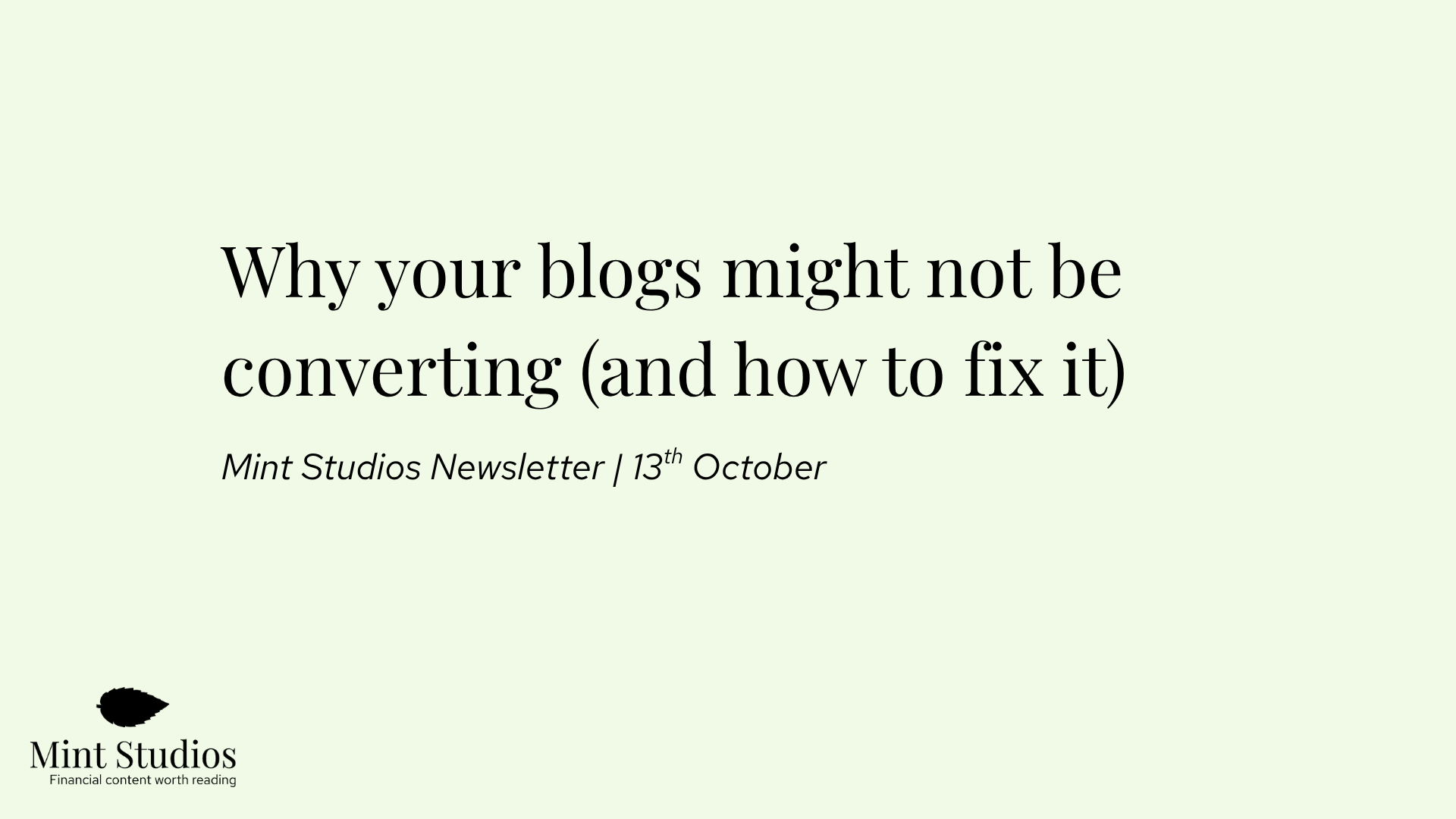The fintech brands of today are creating blocks of ice, hiring celebrities to do shout outs and buying entire sports arenas to stand out.
As Brent Beshore, founder of Permanent Equity, says in one of his podcasts, a brand is more than logos and slogans, it’s “a range of expected outcomes you can expect from any company or person… what you can count on, rely on, and plan around.”
In the financial technology space, where companies are handling and managing people’s money, a brand does a lot of work: standing out from the competition, building trust and educating customers and appealing to a new set of customers.
In this article, we explore eight brands that are doing a good job of building up their brands.
Table of contents
- Why is branding so integral to fintech?
- Zopa: Instagram Marketing
- Klarna: Video marketing
- Lemonade: Transparency and Instagram Marketing
- Starling Bank: Transparency and Newsletter/Content Marketing
- Robinhood: Podcast Marketing
- Onfido: Content Marketing
- Brex: Trade shows
- Tilled: Personal branding
Note: are you a fintech company looking for support with content? We’re a content marketing agency that helps fintech companies turn their blog into a customer acquisition channel. Learn more about what we do.
Why is branding so integral to fintech?
The old startup business model of “bigger numbers and more individual sales” is slowly being overtaken by a new business model: gaining a customer for life and upselling services.
With big data, telematics and Open Banking, financial products can be more personalised than ever. The more you learn about your customer, the better and more tailored your product is: therefore the less likely she is to change provider.
This means that customers are looking for brands that not only sell an excellent product, but that aligns with their values and principles. The brands they use are now part of their identity. And as we said above, when it comes to something as important as personal finance, a brand is not something that’s overlooked.
That’s the main reason branding is important. The second reason is differentiation. There are new fintech companies being launched every quarter, which means competition is high. Branding is increasingly important in order to differentiate a company from its competitors.
For this reason, taking branding seriously can turn into a competitive advantage. With the huge demand for innovation and better products, following the crowd can actually end up being riskier.
Through our own experience helping fintechs from around the world with their content, we’ve come to learn that customer facing fintech brands are made of three main things:
- Education: most millennials and individuals find finances confusing or full of jargon, so fintechs take on the role of educating customers.
- Trust: bank and financial institutions don’t have great reputations, so fintechs have even more work to do in order to build trust with their customers (education ties in well with this).
- Customer experience: younger generations expect the same level of service they get with Uber, Google and Apple. fintechs need to offer a personalised and intuitive user experience.
Read more about this here: Why Fintech Needs Marketing
A successful fintech brand is one which combines those three components above in a unique way – while also becoming reliable and building a set of expected outcomes.
We’ve put together 8 examples of fintechs that we think are doing a great job with their branding in a specific way. The examples range from the UK, to Europe, to other parts of the world. Most of them are customer facing fintechs, however as you’ll see below some B2B fintechs that also doing a great job with their branding.
You may also like: Great Fintech Marketing Strategies For 2023 (Featuring Top Fintech Marketers)
Zopa: Instagram Marketing
Zopa is a peer-to-peer (P2P) lending company that connects investors who want higher returns with borrowers who want easier to access loans. P2P lending blew up after the 2008 financial crash when big banks made it difficult for small businesses to receive loans, forcing them to look elsewhere for funding.
We think Zopa does a great job with their brand. Investing in something via a p2p lender may sound like something complex, risky or scary for most people. But with their “FeelGood Money” campaign, simple to use website and social media strategy, they truly make p2p lending accessible to everyone.
You can see that their fintech marketing strategy ticks all the boxes mentioned above: there’s a ton of educational content on the blog, they’re very approachable and their intuitive banking platform offers a great customer experience (anyone who has invested in other p2p platforms knows how confusing they can be!).
Our favourite part of all is their social media strategy. Although they lack a bit of engagement on Facebook and Twitter, their Instagram is on fire. We’ll just post these on here:



The images are funny, full of character, engaging and educational. Once again, it ticks all the boxes (and we don’t know any other lending platform doing this!).
B2C fintech startups that are navigating a somewhat complex space (like insurance?) should take note of this strategy: is this something that would work for your company? Repurposing blog articles into fun, educational instagram posts doesn’t have to cost thousands - and as you can see it does a great job for their branding.
Klarna: Video and Influencer Marketing
Klarna is a fintech company that allows shoppers to buy products now, and pay for them later with no interest. Their payment solution doubles as a marketing strategy for merchants to acquire customers and allow them to pay later. Shoppers can buy products from Asos, Topshop and other online stores and try clothes on before they buy. Shoppers usually have between 14 and 30 days to pay for their order.
Across all their socials, website and app, their slick customer experience is consistent – exactly what we like when it comes to branding.
But the specific marketing strategy that we (and many others) like is their influencer marketing strategy. They turned a “boring” topic like finance on its head and made it trendy.
How? An entire campaign around the word “Smoooth” and shopping. They literally featured Snoop Dog (turned Smoooth Dog 😍) in several videos with attractive colours, random items and cool hip hop music in the background. Their campaign was a huge success, and it’s very likely you’ve been seeing their ads all over Youtube, buses and online stores.
They challenged the financial services industry with style. Two things we think they did well: video marketing with cool and visually appealing videos, and influencer marketing by featuring a well-known and liked celebrity. Check out the some of the videos we liked:
Lemonade: Transparency and Instagram Marketing
Lemonade offers insurance to renters in the US, Netherlands and Germany. But they’re not just any kind of insurance company: they are super transparent, they take a flat fee every month, pay claims super fast and give back what’s left to important causes.
We’re a huge fan of this Insurtech because we love insurance technology in general, but we also think they’re doing a great job with their branding.
Insurance, like financial services, is notorious for not being transparent, slow and for maximizing premiums while trying to minimize claim payouts - a huge conflict of interest for those paying for insurance. Lemonade is turning the model upside down by aligning interests (they gain nothing by delaying or denying claims) and being super transparent about their model.
One thing that really proves their take on transparency is their ability to admit mistakes. On the Fintech Marketing Podcast, VP of Communications Yael Wissner-Levy explains how they made the mistake of publishing an ad that was slightly distasteful about the insurance industry as a whole – something along the lines of “the insurance industry must give way to a new generation of insurers”.
They got quite a lot of negative feedback. Instead of withdrawing and acting like nothing happened or trying to defend themselves, they took it down and acknowledged the mistake. They admitted that they were still learning how to build their brand and wanted to hear feedback so they could do better next time.
They’ve done a lot of other things for transparency, like publishing their metrics, taking a stand on big topics such as climate change and defending their brand colours from Deutsche Bank. With those strategies, they are successfully ticking the boxes of education (their website copy is refreshing), trust and customer experience (you can submit claims through their mobile app!).
The other thing we think they’re doing an interesting job is on Instagram. Their Instagram has been described as “strangely relaxing”. In any case, it’s definitely unique - you need to see it to understand!
Starling Bank: Transparency and Newsletter/Content Marketing
Starling Bank is a current bank account that exists in your phone as a mobile banking app. There are no bank branches and your debit card is sent in the mail.
Both Starling and Monzo - their rival - do a great job at branding, but since Starling Bank is my (Araminta) business bank, we have more experience with their marketing strategies and how it has influenced me as a customer.
The first thing we like about their marketing is their content strategy. First of all, they have an excellent newsletter cleverly called The Murmur, with very relevant and diverse content - some which we read ourselves! They regularly publish user generated content and feature users who have had success with the app. Second of all, their blog articles are well-written, relevant and engaging.
Starling Bank is also our business digital banking partner, and we really enjoyed their latest campaign giving away money to small entrepreneurs in the UK who are using Starling Bank to manage their finances. For fintechs looking to improve their newsletter marketing, we recommend signing up to Starling’s newsletter to understand why it’s successful.
The second thing we like about Starling is a small - but maybe not so small in the end - surprise that happened a few months ago. There was a mistake with my Starling Euro account, and I was put into overdraft by accident. It was slightly annoying, but I mostly ignored it. However, I was incredibly surprised when one week later there was a hamper delivered at my door with a little note from Starling saying “Sorry for the issues you had with your Euro account”. The hamper had some delicious cheese, lemonade, a cake, chocolate, crackers and more.
Needless to say, I was astonished; I can bet my two forefingers that no other traditional bank would ever do this (and not many neobanks either, to be fair). That action turned a small mistake into a huge win, and I highly respect them for it. An excellent loyalty building strategy.
You may also like: Top B2B Fintech Marketing Tactics (with examples)
Robinhood: Podcast Marketing
Robinhood is a platform that allows individuals to invest in the stock market and cryptocurrency without paying for commissions. They were one of the first in the fintech industry to take the approach of “democratizing stock market investing”, an approach that is visible throughout their entire branding.
They’re doing a lot of great things when it comes to branding, but what we feel makes them really stand out is their daily 3 minute newsletter and daily 15 minute podcast. Both mediums are called the “Robinhood Snacks”, which market themselves as “digestible financial news”. People can read the newsletter in the morning, and listen to the podcast on their commute, while working out or going for a walk. This helps again with being consistent and building a set of expected outcomes for listeners and customers.
Their podcast and newsletter also ticks all the 3 boxes we mentioned above. It really doesn’t get more educational than a financial newsletter (box 1), a podcast is a great way to build trust (box 2), and it’s very unique: there aren’t many fintechs doing podcasts and bite sized newsletters!
Podcasting can take quite a lot of effort to run (Robinhood actually bought the podcast), but once again the ROI is huge. When you’re in your customers’ ears every morning of every day, you become part of their daily routine and are constantly top of mind.

You may like: Top 8 Fintech Blogs to Bookmark
Onfido: Content Marketing
Onfido is an identity verification platform that caters to other fintechs by helping them verify their users’ identity using AI. Anything to do with banking services needs a strong Know Your Customer system in order to reduce fraud and open secure accounts - and that’s where Onfido comes in.
We added them to this list because we wanted to show that B2B fintechs can also have a great marketing strategy that is educational, trust-based and unique. B2B marketing focuses mainly on thought leadership: here’s proof that we know what we’re doing and that we’re the best in the market.
We think Onfido does a great job with this type of marketing. Head over to their “Resources” section to see what we mean: you’ll be presented with a plethora of white papers, case studies, webinars, whitepapers and more. They have it all.
When it comes to B2B marketing, companies need to focus on exactly this kind of content, and Onfido does a great job of that. We don’t see many business banks, banking vendors or other fintech B2B companies doing this - so it’s not a question about resources. This kind of content marketing is what gives them a competitive edge and makes them unique.
B2B fintechs who are still working out their marketing strategy: we recommend checking out Onfido’s white papers and case studies as an example of effective B2B Fintech marketing.
You may also like: 4 Essential Items to Include in Your Fintech Content Marketing Strategy
Brex: Trade shows
Brex is an expense management, online banking and corporate card fintech platform for mid to enterprise level companies.
Although there are various campaigns where they did a great job, there is one particular instance that really highlights who they are as a company.
In a Twitter thread, Sam Blond, ex CRO of Brex, explains how they made the most of a key trade show for them: SaaStr.
With a budget of $50k - $80k, they managed to have a much larger presence than some companies at SaaStr that spent $500k.
In order to make the most of SaaStr, here are four things they did to stand out:
- Sponsor key cards for hotels. When an attendee checked into the hotel, their key card looked like a Brex credit card.
- They hired people dressed in Brex gear giving out “Brexfast” burritos on the corner outside the conference.
- They hired a magician at their booth, where each show somehow incorporated the Brex fintech product offering. There was always a huge crowd at the booth.
- They bought all the bus shelter billboards within a mile of the event.
As Sam says “An attendee would check in to their hotel and get a Brex credit card they need to use several times a day to get in their room. They pass our shelter ads to and from the conference, lunch, dinner, etc. They get a Brexfast burrito as the first thing they experience at the event”.
Although this was just for one event rather than their day to day brand, the consistency and the fact that they remained top of mind at SaaStr meant that their branding had maximum effect.
You can read more about the results of their sponsorship and strategy on Sam’s Twitter thread.
Tilled: Personal branding
In this article we’re mostly writing about company brands. But in this example, we’ll look at how a payment services company built a competitive advantage by first building a personal brand.
Tilled is a payments platform that helps software companies monetise online payment processing by becoming a payment facilitator via an API. 12 months before launching the product, Caleb, Tilled’s founder, started posting on LinkedIn. Every week, he’d chat with his ghostwriter and they’d think of topics that were relevant to the industry. She would then turn those into LinkedIn posts and blog posts for the post.
This type of content helped position Tilled as a thought leader in the market, especially for anything to do with digital payments processing and facilitation. For example, they wrote an article explaining why it was frustrating to work with incumbents like Stripe, something that everyone was thinking but not writing about. The article went viral, helping with awareness of the Tilled product.
We talked to Caleb and he was able to share the numbers since building his personal brand: since founding Tilled, Caleb told us their lead generation flow is over 54%, with a close rate of 59%.
Building a personal brand also helped reduce recruiting costs, and keep their average time to hire at 27 days.
You can learn more about how Caleb built his personal brand here: How Tilled Gets 75% of Leads Inbound with Content Marketing
There are literally thousands of articles out there on how to build a brand. But if there’s anything to learn from the best fintech branding it’s the following: remain consistent in your messaging and focus on building trust.











